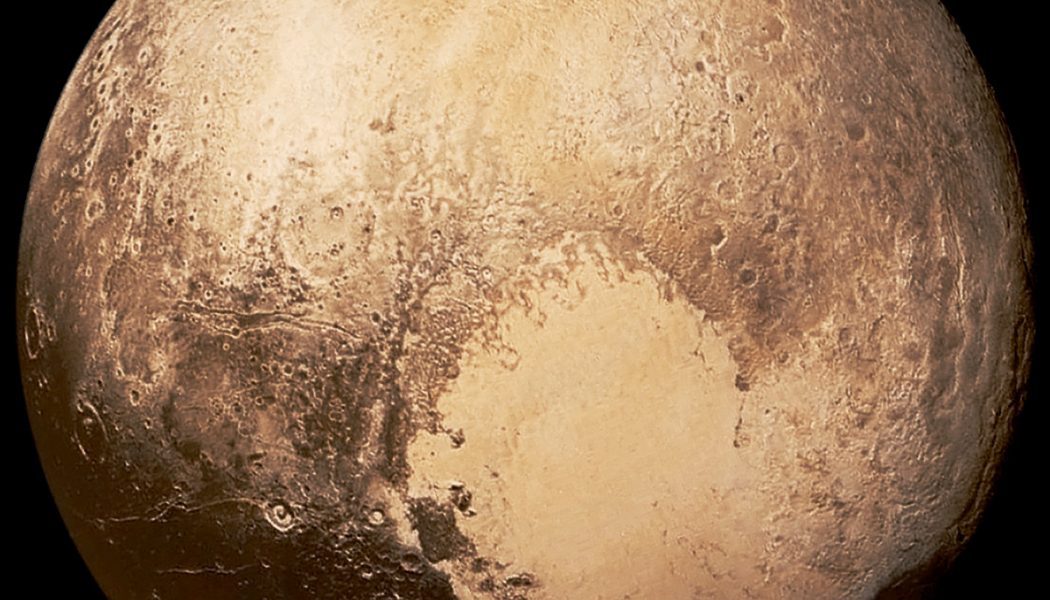The field of astronomy this decade delivered an embarrassment of riches: stunning accomplishment after stunning accomplishment from the exploration of space. Humans sent robots to the farthest reaches of the solar system, to the sun, to the gas giant Jupiter, and more. Meanwhile, our telescopes peered deeper into the cosmos. They showed us images never seen before, like the first-ever image of a black hole, which was just declared to be Science’s “breakthrough of the year.”
We put together our favorite astronomy images and videos from the 2010s, in no particular order. Some of these images are awe inspiring for their beauty, or their remoteness, or for helping us understand our tiny place in the universe. Others are awe inspiring for the engineering achievements they represent, and give hope for what’s possible in the future. There’s the first-ever view of the surface of Pluto, an up-close encounter with a comet, and an entire solar system photographed in its infancy. Behold, and enjoy.
An up-close view of Pluto showed that even dwarf planets can be beautiful, geologically-rich worlds
:no_upscale()/cdn.vox-cdn.com/uploads/chorus_asset/file/19533308/pluto_natural_color_20150714.png)
Before 2015, the very best image of the dwarf planet Pluto was smudgy and blurry, and didn’t reveal a whole lot about the composition of this little world more than 3 billion miles from Earth.
When the New Horizons spacecraft flew past Pluto in July 2015, it revealed that Pluto wasn’t just some boring ball of rock and ice at the end of the solar system. It was a geographically dynamic world. Its mostly smooth surface suggests its crust has been constantly reshaping itself, erasing impact craters. Astronomers even speculate there may be a dynamic, slushy sea underneath Pluto’s heart-shaped basin.
The image above is the highest-resolution image from the New Horizons mission, which was launched in 2006, and arrived at Pluto in 2015. This image, and others like it, instantly became iconic, and a testament to the discoveries that can be made by exploration.
What it’s like on the surface of Pluto
:no_upscale()/cdn.vox-cdn.com/uploads/chorus_asset/file/19533304/796_nh_apluto_mountains_plains_9_17_15_0.jpg)
Here’s another image from the New Horizons mission, and my favorite. It’s a close-up view of Pluto’s surface captured just 15 minutes after New Horizon’s closest approach to the planet. It shows 11,000 foot tall mountains and icy planes, and you can even see tiny wisps of Pluto’s extremely thin atmosphere in arch-shaped lines above the surface.
The preceding photo shows what Pluto looks like; this one helps us understand what it would be like to be there, on the surface. Pluto may be a dwarf planet, but it’s an entire world.
Jaw-dropping images of Jupiter, sent back by Juno
:no_upscale()/cdn.vox-cdn.com/uploads/chorus_asset/file/19534306/pia22949.jpg)
On July 4, 2016, NASA’s Juno spacecraft arrived at Jupiter, traveling at a blistering 130,000 miles per hour.
Since then, as it orbited the largest planet in our solar system, Juno has revealed many secrets. They include enormous new cyclones swirling around the planet’s poles, a magnetic field that’s much more variable than expected, a belt of ammonia encircling Jupiter’s equator, and some evidence that Jupiter’s core is not as dense and compact as once thought.
:no_upscale()/cdn.vox-cdn.com/uploads/chorus_asset/file/19536256/35071652633_091cc2c7ae_o.jpg)
Juno is delivering unprecedented, beautiful portraits of Jupiter. The images processed by NASA and citizen scientists are arresting: one part van Gogh, one part Pillars of Creation. Jupiter’s clouds have a stormy, gauzy quality, like cream swirling in the largest imaginable cup of coffee. Add to that the awesome size of what’s in them: Even small details on Jupiter can be larger than the entire Earth.
Consider the image above of Jupiter’s Great Red Spot. You could fit three Earths inside its vortex.
This is the very first image of a black hole
:no_upscale()/cdn.vox-cdn.com/uploads/chorus_asset/file/19534298/blackhole20190410.jpg)
In April 2019, an international collaboration of scientists called the Event Horizon Telescope told the world that, for the first time, humanity has peered into the edge of a black hole.
The supermassive black hole is at the center of the Messier 87 (M87) galaxy, 53.49 million light-years away. The black hole, called M87, is massive, some 6.5 billion times the mass of our sun, all contained in a single point of infinite density.
In the image, the visible reddish and white light surrounding the black hole is material being destroyed by its immense gravity. That light encircles the photon orbit, a region beyond which light could conceivably escape from but is unlikely to. Within that photon orbit is the event horizon, the region beyond which no light can escape.
As you look at this image, know that this isn’t an object. This is a shadow, a sink. The light in the center gets sucked out of our view irretrievably. The absence in the image means something has left our observable universe. It’s a truly remarkable moment for humans to be able to see something so enigmatic, so far away, and so incredibly difficult to capture.
Stars orbiting the black hole in the center of our galaxy
The image of M87 shows what a black hole’s event horizon looks like. This GIF is a testament to the amazing power of black holes.
This is a timelapse of 20 years of observations from the European Southern Observatory’s Very Large Telescope looking at stars in orbit around the black hole at the center of our own galaxy, called Sagittarius A*. And yes, the stars — some more massive than our sun — orbit the black hole, like our planet orbits the sun. (The black hole isn’t seen in this image. But look at the center of the image to see a star doing a complete loop around an empty bit of space.)
One of the stars in this array, called S2, recently passed by the black hole at a speed greater than 15.5 million miles per hour. That’s more than 4,300 miles every second, or nearly three percent of the speed of light. Scientists recently used this observation in a test that, once again, proves Albert Einstein’s theory of gravity is correct.
And here’s a cleaner, illustrated version of similar observations. The orbital path of the star S2 is outlined in yellow.
Hubble catches an interstellar visitor
:no_upscale()/cdn.vox-cdn.com/uploads/chorus_asset/file/19499133/STSCI_H_p1961b_d_1280x720.png)
This is a recent Hubble Space Telescope image of a comet that is passing through our solar system. It was born around a star that is not our own, then flung off into space by some unknown cataclysm.
But it’s not here to stay. It’s moving at around 100,000 miles per hour, which is much too fast for even our mighty sun to capture it in its orbit. (For reference, Voyager 1, the spacecraft that’s has left our solar system, is traveling at around 35,000 miles per hour.) The comet, named 2I/Borisov, is only the second interstellar object recorded in our solar system. The first, a cigar-shaped rock (also probably a comet of sorts), named Oumuamua, was discovered in 2017.
The above image was taken on November 16. The bright blue object in the center is the comet, approximately 203 million miles away from the Earth. The smudgy object to the left of it is actually a spiral galaxy 390 million light-years in the background. How’s that for an extreme contrast in scale? The core of the comet is probably less than a mile wide.
The Rosetta mission delivered a serene portrait of a comet
The European Space Agency’s Rosetta mission was the first ever to actually land a probe onto the surface of a comet. The mission launched in 2004, and arrived at the comet in 2014.
The comet, named 67P/Churyumov-Gerasimenko, is a little more than 2.5 miles wide. It’s amazing that we could navigate to something so small in the vastness of space. The above image, captured in 2015, shows the comet in stunning detail. (In the area outlined by the circle, scientists discovered a tiny chunk of material actually orbiting the comet. It’s like a teeny tiny moon. The scientists dubbed it “Churymoon.”)
Perhaps even more exciting is this close-up timelapse of the surface of the comet. It’s almost cinematic. In the foreground, dust and cosmic rays look like a snowstorm. And you can clearly see the craggy features of the comet. It makes it easier to imagine what it’s like to ride on a comet.
The solar eclipse inspired millions to stop and look at our star, the sun
:no_upscale()/cdn.vox-cdn.com/uploads/chorus_asset/file/19533498/837622854.jpg.jpg)
When people write the history of the past decade in the United States, they’ll mention all the moments of division, the conflict, and the bleak status of our polarized politics. I hope they also include a bit about the one moment nearly all Americans were unified.
On August 21, 2017, 88 percent of Americans — 216 million people — took time to witness a solar eclipse that bisected the continental United States. It was a stunning moment, when millions of us were awestruck by the same rare phenomenon.
The above photo of the eclipse was taken in Chester, Illinois. But a similar view could be found anywhere along the eclipse’s path between Oregon and South Carolina.
Cassini’s last look at Saturn reminds us why we need to go back
NASA’s Cassini mission ended in a fiery finale in 2017 when the spacecraft dove into Saturn after more than a decade in its orbit. These are the last series of images Cassini seen before its demise. In the timelapse, you see the icy moon Enceladus setting behind Saturn.
It’s a picture that represents so much.
Many years earlier, Cassini discovered that Enceladus has a remarkable feature: Plumes of water vapor and gas shoot out of cracks in the surface. That water means there’s a liquid ocean beneath the ice-covered surface, which may have geothermal vents like those found at the bottom of our oceans.
The discovery was immense: It shot Enceladus to the top of the list of places where we could possibly find life in our solar system. It could be the site of a second genesis — where life formed, evolved, and prospered undisturbed on another world. If even a few small microbes were found in its waters, it would be one of the greatest scientific findings of all time.
This image above says farewell to Enceladus, but it also beckons; we must, someday, go back to see if there’s life there.
A view of the Earth, from Saturn
:no_upscale()/cdn.vox-cdn.com/uploads/chorus_asset/file/9254955/5868_IMG004868.jpg)
This will probably be remembered as the most famous image from the Cassini mission. It’s a picture of the Earth, as seen from the dark side of Saturn (the cursor on the image points out the Earth. We’re just a speck of dust.
The Curiosity Rover takes a selfie on Mars
:no_upscale()/cdn.vox-cdn.com/uploads/chorus_asset/file/19533411/pia19920_bigsky_selfie.jpg)
In 2012, the Curiosity Rover touched down on the surface of Mars, after a perilous journey on what NASA dubbed a skycrane (the rover was too heavy to land via parachutes, so NASA used rockets). And ever since, it’s been hard at work, investigating Mars for signs of life and probing its geologic history.
The above picture is a selfie (one of many) taken by the rover in 2015. In its time on Mars, Curiosity has confirmed that the planet used to be home to flowing water, with rivers and lakes, and had a past where the planet could have been hospitable to life.
In July 2020, NASA will launch the Mars 2020 rover — a vehicle similar to Curiosity — to an ancient dried-up river delta on the Martian surface, looking for more clues to piece together the natural history of the red planet.
A solar system is born
:no_upscale()/cdn.vox-cdn.com/uploads/chorus_asset/file/19535973/eso1436a.jpg)
In 2014, the radio ALMA observatory in Chile captured this image of a star 450 light years away. The star is at the center of the image, but surrounding it are rings of material left over from the birth of the star. (Like the planet Saturn has rings, stars can have rings, too).
Looking at the image, astronomers have found evidence that planets are forming out of the material in those rings. This is the beginning of an entire solar system, perhaps one not so different than ours. When we look at the birth of this solar system, we’re looking at a process that likely birthed our own.
Hubble’s eXtreme Deep Field reminds us how impossibly large the universe is
:no_upscale()/cdn.vox-cdn.com/uploads/chorus_asset/file/19533502/690958main_p1237a1.jpg)
Everywhere in the universe we look, there are vast discoveries to be found.
The above image is the Hubble space telescope’s eXtreme Deep Field observation, published in 2012. The image is the result of combining 1,000 exposures of a teeny tiny patch of sky taken over 10 years. The image contains 5,500 galaxies found in a portion of the night sky that’s smaller than one-tenth the width of the moon. As the Hubble website explains, this is just “a 30 millionth of the whole sky.” So in every thumbnail-sized area of the sky, there’s untold numbers of galaxies, stars, planets, and possibly life. It’s mind boggling, and awesome.








